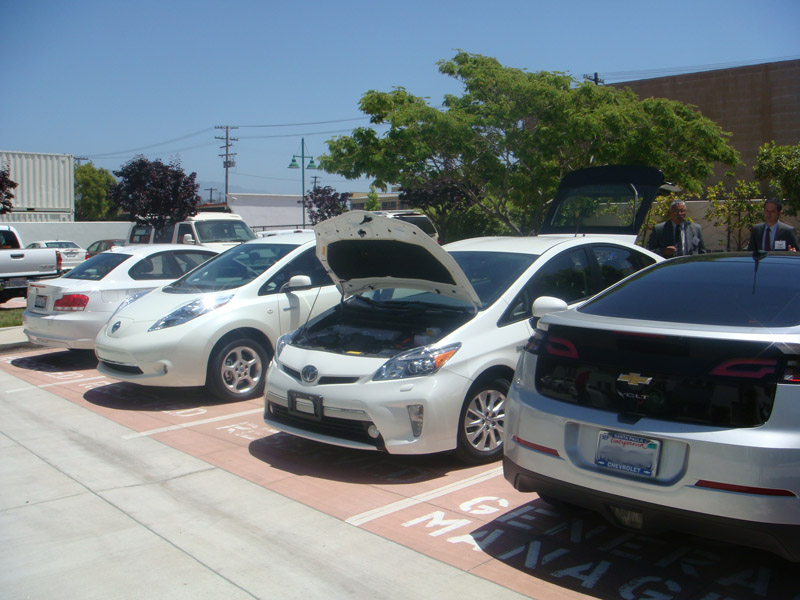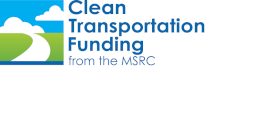 Electric Vehicles (EVs) are making a dramatic re-entry into the California and national marketplace. In the 1990s, Clean Transportation Funding from the MSRC supported EV Charging directional signs as well as initial consumer incentives. Plug-in electric vehicle readiness for cities and communities is a critical component of advancing EVs and supporting local economic activity. A future story will explore community readiness issues around codes, permitting, planning and station installation . However, this article focuses on the electric cars that are currently (or soon to be) on Southern California roadways and the incentive programs to advance their deployment.
Electric Vehicles (EVs) are making a dramatic re-entry into the California and national marketplace. In the 1990s, Clean Transportation Funding from the MSRC supported EV Charging directional signs as well as initial consumer incentives. Plug-in electric vehicle readiness for cities and communities is a critical component of advancing EVs and supporting local economic activity. A future story will explore community readiness issues around codes, permitting, planning and station installation . However, this article focuses on the electric cars that are currently (or soon to be) on Southern California roadways and the incentive programs to advance their deployment.
California has long been the leader in promoting zero emission plug-in electric vehicles (EVs) and today up to 50 percent of national EV sales are in California according to Alec Gutierrez, senior market analyst for automotive insights at Kelley Blue Book. A diverse array of EVs is now being sold in California and around the world and many more will be arriving later this year and in 2013 and 2014.
At this relatively early stage in the resurgent EV marketplace, sales already are significantly more robust than comparable sales of the first generation of hybrid vehicles were more than a decade ago. However, total EV sales continue to make up just a sliver of all new car sales in California and nationally. More robust electric charging infrastructure and improved battery technology (longer range for less cost) for EVs will likely be required before they will be more widely accepted by consumers.
Helping to drive electric vehicle production is California's zero emissions vehicle (ZEV) regulation that requires automakers to sell an increasing number of zero emission vehicles in the state - and those that can't meet their targets can buy "credits" from automakers that can. The more advanced the vehicle, the more credits it gets. Although the price of the deals are private, credits tend to sell for $5,000 to $10,000 each, says Bloomberg Businessweek.
In January, California adopted its latest update to the standards, with a goal of getting 1.4 million ZEV and hybrid vehicles on the road by 2025. Two percent of vehicles must be ZEVs for automakers that sell more than 60,000 vehicles in the state from 2012-2014 and that percentage rises to 15 percent by 2025. In 2018, the rules also will apply to automakers that sell more than 20,000 vehicles in the state. California now requires a 50 percent reduction from current levels, rising to 75 percent by 2025. 14 other states have adopted California's smog emissions rules and 10 states have adopted its ZEV mandates, including New York, Massachusetts and Connecticut.
While the ZEV regulation is encouraging nearly all automotive manufacturers to sell EVs, some are marketing what are being called “compliance cars” or a very limited number of cars in states that require them based on their regulatory obligation, while other manufacturers are selling vehicles nationally that they hope to mass produce. The first round of requirements applies only to the carmakers with the highest California sales. In order, they are: Toyota, Honda, GM, Ford, Nissan, and Chrysler.
The major volume EVs on the U.S. market currently include the Nissan Leaf and the Chevy Volt, which both qualify for California's HOV lane and receive a $2500 tax credit from California and a federal tax credit of $7500. Chevy Volt sales have recently surged in California. The Toyota Plug-In Prius, which qualifies for a $2500 federal tax credit, saw strong initial sales. In March, more than 80 percent of sales were in California.
Additionally, the Coda Sedan, Toyota RAV 4, and Mitsubishi ‘i’ are currently available and later this year the Ford Focus Electric and Tesla Model S will go on sale. By 2014, BMW, Chevy, Fiat, Honda, Scion, Smart, Tesla, Toyota and Volkswagen all will be providing plug-in entries.
On the charging infrastructure front in California, NRG Energy, Inc. settled a lawsuit with the state by agreeing to install $100 million worth of EV charging equipment. However, some regulatory and legal issues remain, because Ecotality, a competing electric vehicle charging station provider recently filed suit against the settlement terms alleging that the agreement, giving NRG 18 months of exclusive rights to operate charging stations, is illegal.
Ecotality separately has a grant from the Department of Energy to install 1,000 home charging stations for free and most California utilities are offering incentives (up to $2,000 rebate to cover electrical installation costs) to consumers. Interestingly, more than half of California electric car buyers to date are choosing to not purchase fast charging stations for their homes.
As with any new technology, incentives and public charging infrastructure will be critical to success, but the car manufacturers have shown the technology is available to create a wide variety of cutting edge electric cars….now Drivers are Wanted.
